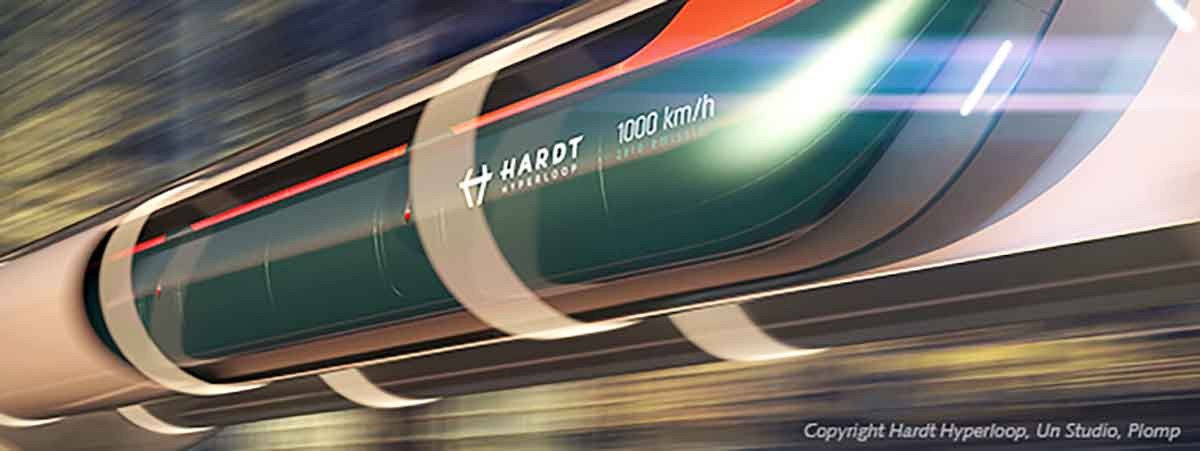Traveling at the speed of sound on earth – the only economical way to do this is to use vacuum tubes. Work on making the Hyperloop concept a reality is currently underway in places like Delft in the Netherlands, where they are using vacuum pumps from Busch.
What is the most energy-efficient and environmentally friendly way to organize the future of transport? Current modes of transport are either reaching their limits or are putting an increasing amount of strain on the environment as usage rates rise. SpaceX founder Elon Musk has suggested a completely new approach to solving the problem: Hyperloop. The idea is that electromagnetically powered trains will travel at the speed of sound, whizzing through vacuum tubes at almost zero air resistance.
Suspended in mid-air
Musk is counting on the world's tech-nerds to bring this idea to life. He set up a competition, in which candidates – mainly universities and groups of students – tried to develop a technical solution for the concept. One such group was based at Delft University of Technology in the Netherlands. In 2017, its vehicle concept won the first SpaceX Hyperloop Competition. The group then evolved into the start-up company Hardt, which is also based in Delft.
Alongside the vacuum tubes, frictionless electromagnetic motion is at the core of the Hyperloop idea. Its principles are already in use in magnetically levitating trains, which were originally developed in Germany and are now used in China. However, the young engineers from Delft made some crucial updates to the concept in their approach. Their vehicle, or "pod", does not float on a magnetic field over a rail. Instead, the rail is at the top and the pod hangs underneath it, where it is held in place by a permanent magnet on board the vehicle. At the same time, an electromagnet counteracts the permanent magnet, which creates a small gap between the rail and vehicle suspension. Coils in the rail are responsible for applying the energy and moving the pod.
A successful test
So far, this setup has been successfully tested in a 30-meter-long vacuum tube with a diameter of three meters. A vacuum system from Busch was used for evacuation. It empties the 130-cubic-meter cavity in around 40 minutes down to a vacuum level of 1 millibar. This corresponds to 99.9 percent vacuum. The trials in this setup demonstrated that the technology works in principle.
Incidentally, the inside of the pod is a pressurized cabin, similar to those on aircraft. Since the vacuum tubes do not contain any oxygen for respiration, Hardt has drawn on to technology used in the aerospace industry to supply passengers with air to breathe. A three-kilometer test track is due to be launched as early as this year, enabling the pod to be tested at high speeds. The vacuum supply for this track – which will be a lot more intricate – will once again be supplied by Busch.

Racing Through the Tubes at 1000 km/h
Super fast train travel in vacuum
What does speed have to do with vacuum?
A cyclist traveling at a speed of 30 kilometers per hour has to pedal four times as hard as a cyclist moving at just 15 km/h. Air resistance is therefore proportional to speed squared. So, for this reason, a super sports car with 1000 horsepower, for instance, is unable to reach much more than double the top speed of a modest family saloon. The enormous level of air resistance encountered at high speeds is nothing more than the vehicle colliding with the gas molecules in the air and the force required to "push them aside". In vacuum, this displacement is not needed and there is no resistance. And because an electromagnetically suspended vehicle also does not experience any rolling resistance, almost all of the driving force in a vacuum tube is converted into speed.
A cyclist traveling at a speed of 30 kilometers per hour has to pedal four times as hard as a cyclist moving at just 15 km/h. Air resistance is therefore proportional to speed squared. So, for this reason, a super sports car with 1000 horsepower, for instance, is unable to reach much more than double the top speed of a modest family saloon. The enormous level of air resistance encountered at high speeds is nothing more than the vehicle colliding with the gas molecules in the air and the force required to "push them aside". In vacuum, this displacement is not needed and there is no resistance. And because an electromagnetically suspended vehicle also does not experience any rolling resistance, almost all of the driving force in a vacuum tube is converted into speed.